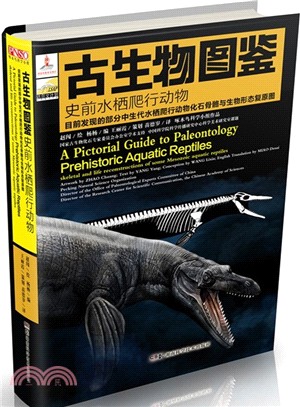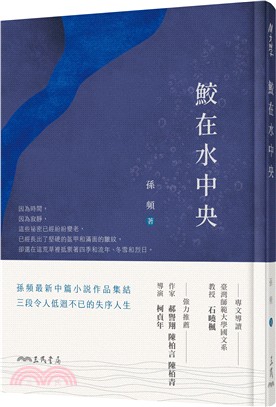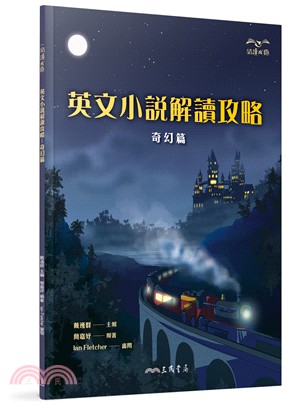商品簡介
作者簡介
名人/編輯推薦
目次
書摘/試閱
相關商品
商品簡介
《古生物圖鑒史前水棲爬行動物》系列叢書以世界最具代表性的古生物化石為依據,科學、準確地將60余種世界各地發現的史前水棲爬行動物骨骼及形態進行完美復原,將物種的化石產地、基本體型、生存年代、食性等特征以中英文雙語進行介紹。
《古生物圖鑒史前水棲爬行動物》是全球首套專業級的恐龍工具書,為中國乃至全球的古生物研究者的科研與教學工作提供了豐富的、翔實的圖片與數據資源。
《古生物圖鑒史前水棲爬行動物》是全球首套專業級的恐龍工具書,為中國乃至全球的古生物研究者的科研與教學工作提供了豐富的、翔實的圖片與數據資源。
作者簡介
名人/編輯推薦
《古生物圖鑒史前水棲爬行動物》60余種世界各地發現的著名史前水棲爬行動物骨骼及形態,用科學的方法進行了復原。
本書全四色銅版印刷,精裝。對開大圖完美復原史前水棲爬行動物。
全球首發,以中英文雙語的方式將60余種生活在中生代的水棲爬行動物的標準中文名稱、學名、命名者的資料進行收集,整理了物種的化石產地、基本體型、生存年代、食性等基本特征。
中國原創,且是全球唯一一套最系統、最齊全、最科學、最精美的史前水棲爬行動物復原圖鑒。
本書以全新的表現形態為古生物的研究工作、教學工作、展示工作提供科學、有效、實用的幫助。
古生物研究者與愛好者可以共享的一套古生物叢書。
精準、科學、藝術的將曾經的地球霸主進行完美復原,讓它們重新站立在大眾面前,讓我們可以直觀地了解它們,確切的認識它們。
本書全四色銅版印刷,精裝。對開大圖完美復原史前水棲爬行動物。
全球首發,以中英文雙語的方式將60余種生活在中生代的水棲爬行動物的標準中文名稱、學名、命名者的資料進行收集,整理了物種的化石產地、基本體型、生存年代、食性等基本特征。
中國原創,且是全球唯一一套最系統、最齊全、最科學、最精美的史前水棲爬行動物復原圖鑒。
本書以全新的表現形態為古生物的研究工作、教學工作、展示工作提供科學、有效、實用的幫助。
古生物研究者與愛好者可以共享的一套古生物叢書。
精準、科學、藝術的將曾經的地球霸主進行完美復原,讓它們重新站立在大眾面前,讓我們可以直觀地了解它們,確切的認識它們。
目次
致謝Acknowledgments
序Foreword
前言Preface
史前水生爬行動物The prehistoric aquatic reptiles
魚龍超目 Ichthyopterygia
歌津魚龍科 Utatsusauridae
屈頂歌津魚龍Utatsusaurus hataii Shikama, Kamei et Murata, 1978
短尾魚龍科 Grippidae
龜山巢湖龍Chaohusaurus geishanensis Young et Dong, 1972
魚龍目 Ichthyosauria
浮游杯椎魚龍Cymbospondylus natans Leidy, 1868
瑪瑙混魚龍Mixosaurus cornalianus (Bassani, 1886) Baur, 1887
西藏喜馬拉雅魚龍Himalayasaurus tibetensis Dong, 1972
通俗肖尼魚龍Shonisaurus popularis Camp, 1976
臥龍崗卡洛維龍Callawayia oweni Chen,Cheng et Sander, 2007 致謝Acknowledgments
序Foreword
前言Preface
史前水生爬行動物The prehistoric aquatic reptiles
魚龍超目 Ichthyopterygia
歌津魚龍科 Utatsusauridae
屈頂歌津魚龍Utatsusaurus hataii Shikama, Kamei et Murata, 1978
短尾魚龍科 Grippidae
龜山巢湖龍Chaohusaurus geishanensis Young et Dong, 1972
魚龍目 Ichthyosauria
浮游杯椎魚龍Cymbospondylus natans Leidy, 1868
瑪瑙混魚龍Mixosaurus cornalianus (Bassani, 1886) Baur, 1887
西藏喜馬拉雅魚龍Himalayasaurus tibetensis Dong, 1972
通俗肖尼魚龍Shonisaurus popularis Camp, 1976
臥龍崗卡洛維龍Callawayia oweni Chen,Cheng et Sander, 2007
長嘴真鼻龍Eurhinosaurus longirostris (Mantell, 1851) Abel, 1909
板齒離片齒龍Temnodontosaurus platyodon Lydekker, 1889
艾森奈庫斯大眼魚龍Ophthalmosaurus icenicus Seeley, 1874
平趾扁鰭魚龍Platypterygius platydactylus(Broili, 1907) von Huene, 1922
窄吻狹翼魚龍Stenopterygius quadriscissus (Von Quenstadt, 1858) Jaekel, 1904
皮氏加利福尼亞魚龍Californosaurus perrini (Merriam, 1902) Kuhn, 1934
周氏黔魚龍Qianichthyosaurus zhoui Li, 1999
典型魚龍Ichthyosaurus communis (De la Beche et Conybeare, 1821) Conybeare, 1822
有鱗目 Squamata
滄龍科 Mosasauridae
霍夫曼滄龍 Mosasaurus hoffmanni (Conybeare,1822) Mantell, 1829
原蟒硬椎龍Clidastes propython Cope, 1869
穆亙浩溫亙莫那龍Moanasaurus mangahouangae Wiffen, 1980
本尼森浮龍Plotosaurus bennisoni Camp, (1942) 1951
索爾維傾齒龍Prognathodon solvayi Dollo, 1889
阿拉巴馬球齒龍Globidens alabamensis Gilmore, 1912
馬氏扁掌龍Plioplatecarpus marshi Dollo, 1882
鼓膜板踝龍Platecarpus tympaniticus Cope, 1869
波氏安哥拉龍Angolasaurus bocagei Telles-Antunes, 1964
貝爾納迪海諾龍Hainosaurus bernardi Dollo, 1885
普氏海王龍Tylosaurus proriger (Cope, 1869) Marsh, 1872
歐氏海怪龍Taniwhasaurus oweni Hector, 1874
扁平大洋龍Halisaurus platyspondylus Marsh, 1869
鰭龍超目 Sauropterygia
海龍形類 Thalattosauriformes
海龍目 Thalattosauria
意大利迷幻龍 Askeptosaurus italicus Nopcsa, 1925
黃果樹安順龍Anshunsaurus huangguoshuensis Liu, 1999
孫氏新鋪龍 Xinpusaurus suni Yin, 2000
齒龍目 Placodontia
扁齒龜龍Placochelys placodonta Jaekel, 1902
新鋪中國豆齒龍Sinocyamodus xinpuensis Li, 2000
巨大齒龍 Placodus gigas Agassiz, 1833
多板礫甲龜龍Psephochelys polyosteoderma Li et Rieppel, 2002
真鰭龍類 Eusauropterygia
幻龍目 Nothosauroidea
胡氏貴州龍Keichousaurus hui Young, 1958
鮑氏鷗龍Lariosaurus balsami Curioni, 1847
興義鷗龍Lariosaurus xingyiensis Li, Liu et Rieppel, 2002
奇異幻龍Nothosaurus mirabilis Münster, 1834
純信龍類 Pistosauroidea
李氏云貴龍Yunguisaurus liae Cheng, Sato, Wu et Li, 2006
長壽純信龍Pistosaurus longaevus Meyer, 1839
蛇頸龍目 Plesiosauria
上龍亞目 Pliosauroidea
楊氏璧山上龍Bishanopliosaurus youngi Dong, 1980
澄江渝州上龍Yuzhoupliosaurus chengjiangensis Zhang, 1985
普克蘭彪龍Rhomaleosaurus cramptoni Carte et Bailey, 1863 &nbs
序Foreword
前言Preface
史前水生爬行動物The prehistoric aquatic reptiles
魚龍超目 Ichthyopterygia
歌津魚龍科 Utatsusauridae
屈頂歌津魚龍Utatsusaurus hataii Shikama, Kamei et Murata, 1978
短尾魚龍科 Grippidae
龜山巢湖龍Chaohusaurus geishanensis Young et Dong, 1972
魚龍目 Ichthyosauria
浮游杯椎魚龍Cymbospondylus natans Leidy, 1868
瑪瑙混魚龍Mixosaurus cornalianus (Bassani, 1886) Baur, 1887
西藏喜馬拉雅魚龍Himalayasaurus tibetensis Dong, 1972
通俗肖尼魚龍Shonisaurus popularis Camp, 1976
臥龍崗卡洛維龍Callawayia oweni Chen,Cheng et Sander, 2007 致謝Acknowledgments
序Foreword
前言Preface
史前水生爬行動物The prehistoric aquatic reptiles
魚龍超目 Ichthyopterygia
歌津魚龍科 Utatsusauridae
屈頂歌津魚龍Utatsusaurus hataii Shikama, Kamei et Murata, 1978
短尾魚龍科 Grippidae
龜山巢湖龍Chaohusaurus geishanensis Young et Dong, 1972
魚龍目 Ichthyosauria
浮游杯椎魚龍Cymbospondylus natans Leidy, 1868
瑪瑙混魚龍Mixosaurus cornalianus (Bassani, 1886) Baur, 1887
西藏喜馬拉雅魚龍Himalayasaurus tibetensis Dong, 1972
通俗肖尼魚龍Shonisaurus popularis Camp, 1976
臥龍崗卡洛維龍Callawayia oweni Chen,Cheng et Sander, 2007
長嘴真鼻龍Eurhinosaurus longirostris (Mantell, 1851) Abel, 1909
板齒離片齒龍Temnodontosaurus platyodon Lydekker, 1889
艾森奈庫斯大眼魚龍Ophthalmosaurus icenicus Seeley, 1874
平趾扁鰭魚龍Platypterygius platydactylus(Broili, 1907) von Huene, 1922
窄吻狹翼魚龍Stenopterygius quadriscissus (Von Quenstadt, 1858) Jaekel, 1904
皮氏加利福尼亞魚龍Californosaurus perrini (Merriam, 1902) Kuhn, 1934
周氏黔魚龍Qianichthyosaurus zhoui Li, 1999
典型魚龍Ichthyosaurus communis (De la Beche et Conybeare, 1821) Conybeare, 1822
有鱗目 Squamata
滄龍科 Mosasauridae
霍夫曼滄龍 Mosasaurus hoffmanni (Conybeare,1822) Mantell, 1829
原蟒硬椎龍Clidastes propython Cope, 1869
穆亙浩溫亙莫那龍Moanasaurus mangahouangae Wiffen, 1980
本尼森浮龍Plotosaurus bennisoni Camp, (1942) 1951
索爾維傾齒龍Prognathodon solvayi Dollo, 1889
阿拉巴馬球齒龍Globidens alabamensis Gilmore, 1912
馬氏扁掌龍Plioplatecarpus marshi Dollo, 1882
鼓膜板踝龍Platecarpus tympaniticus Cope, 1869
波氏安哥拉龍Angolasaurus bocagei Telles-Antunes, 1964
貝爾納迪海諾龍Hainosaurus bernardi Dollo, 1885
普氏海王龍Tylosaurus proriger (Cope, 1869) Marsh, 1872
歐氏海怪龍Taniwhasaurus oweni Hector, 1874
扁平大洋龍Halisaurus platyspondylus Marsh, 1869
鰭龍超目 Sauropterygia
海龍形類 Thalattosauriformes
海龍目 Thalattosauria
意大利迷幻龍 Askeptosaurus italicus Nopcsa, 1925
黃果樹安順龍Anshunsaurus huangguoshuensis Liu, 1999
孫氏新鋪龍 Xinpusaurus suni Yin, 2000
齒龍目 Placodontia
扁齒龜龍Placochelys placodonta Jaekel, 1902
新鋪中國豆齒龍Sinocyamodus xinpuensis Li, 2000
巨大齒龍 Placodus gigas Agassiz, 1833
多板礫甲龜龍Psephochelys polyosteoderma Li et Rieppel, 2002
真鰭龍類 Eusauropterygia
幻龍目 Nothosauroidea
胡氏貴州龍Keichousaurus hui Young, 1958
鮑氏鷗龍Lariosaurus balsami Curioni, 1847
興義鷗龍Lariosaurus xingyiensis Li, Liu et Rieppel, 2002
奇異幻龍Nothosaurus mirabilis Münster, 1834
純信龍類 Pistosauroidea
李氏云貴龍Yunguisaurus liae Cheng, Sato, Wu et Li, 2006
長壽純信龍Pistosaurus longaevus Meyer, 1839
蛇頸龍目 Plesiosauria
上龍亞目 Pliosauroidea
楊氏璧山上龍Bishanopliosaurus youngi Dong, 1980
澄江渝州上龍Yuzhoupliosaurus chengjiangensis Zhang, 1985
普克蘭彪龍Rhomaleosaurus cramptoni Carte et Bailey, 1863 &nbs
書摘/試閱
什么是史前水棲爬行動物
1. 什么是史前水棲爬行動物
從兩棲動物到爬行動物,是脊椎動物演化史上的一次革命性變革。爬行動物是自脊椎動物誕生以來,首次不再完全依賴水體的脊椎動物,它們大大拓展了自己的生存空間 。
從水生到陸生,再到空中,這是脊椎動物所經歷的漫長而復雜的演化過程,但是在這個演化過程中,卻有一些爬行動物選擇了不同的演化路徑。它們在陸上度過了無數個難忘的光陰后,終于決定重新返回水里,而不是沿著前輩的道路繼續行進。
這樣“反常”的演化,或許更多的是出于殘酷的生存競爭壓力。對于生的渴望,讓它們重新回到了競爭相對較小的水里,在那里,它們會有更多的食物,更廣闊的生存空間。
我們把這些動物稱為水棲爬行動物。
水生爬行動物大約在二疊紀時就已出現,中龍(Mesosaurus)就是最為典型的代表,而其中很大一部分甚至生存到了現代,但是它們集中出現的時間為中生代(距今大約2.5億年~ 6500 萬年)。
本冊圖書所描述的水生爬行動物正是生存于中生代的水棲爬行動物, 我們稱它們為史前水棲爬行動物。
它們是當時水中占據優勢的物種,根據不同的身體結構和習性,生存在湖泊、河流、近海、遠海、淺海、深海等不同的生存環境中, 并位于當地的食物鏈頂端。
雖然如此,史前水棲爬行動物依舊沒能逃脫滅亡的厄運, 它們的生命在白堊紀末期都走向了終結。 其中,魚龍目(Ichthyosauria)大約生存了 1.5 億年,蛇頸龍目(Plesiosauria)生存了 1.85 億年,而海中巨無霸滄龍科(Mosasauridae)僅生存了大約3000萬年。
究竟是什么原因導致強大的史前水棲爬行動物走向滅絕,雖然科學家已經提出了很多假設,但到目前為止并沒有定論。
2. 史前水棲爬行動物的分類
史前水棲爬行動物包羅的類別非常廣,其中最為重要的有以下幾類:魚龍目(Ichthyosauria),滄龍科(Mosasauridae),海龍目(Thalattosauria),齒龍目(Placodontia),幻龍目(Nothosauroidea),蛇頸龍目(Plesiosauria),原龍目(Protorosauria),鱷形類動物(Crocodyliforms),龜鱉類(Turtles)等。
這些類別在本冊圖書中均有介紹。
3. 史前水棲爬行動物的特點
重新返回水中的爬行動物,首先在其身體結構上發生了非常大的改變,隨之而來的還有它們的生產方式、 行為方式等。 這是一個艱難而又漫長的過程, 不過,要適應新的生存環境,它們別無選擇。
史前水棲爬行動物的身體大都具有流線型,就像現在的海豚一般,脖子和身體幾乎連成一線,這樣有助于它們減少在水中運動的阻力。
因為可以依賴水的浮力,它們不需要再費力地支撐沉重的身體,所以它們的胸骨、肋骨、四肢等都逐漸變細。但它們的脊椎骨會變得相對粗壯,而且能夠靈活地擺動,這樣才能更有利于它們在水中前行。
它們的四肢在入水后會慢慢變成指(趾)間帶蹼的鰭狀肢,而它們的尾巴會變成寬鰭,來為它們劃水提供足夠的動力。
因為身體結構及生存環境的變化,它們的行為方式也會發生很大的改變,最為突出的就是它們的繁殖方式。它們中很大一部分成員不再像普通的爬行動物采用卵生的方式,而是采用全新的卵胎生的方式。不需要將自己的后代包裹在蛋殼中進行孵化,而是直接將它們的幼體產在水中。
4. 史前水棲爬行動物的研究歷史
史前水棲爬行動物雖然不像恐龍那樣被大眾所熟知,但是它們的發現與研究歷史卻比恐龍要早很多。
早在 1699 年,學者們就描述了發現于英國威爾士的魚龍化石殘片。1708 年,又有兩篇文章提到了魚龍目的脊椎骨化石, 但當時并沒有被科學地歸為魚龍目,人們認為它們是屬于那些在圣經記載的大洪水中死去的“邪惡人類”。隨后,在 1780 年,人們在荷蘭發現了滄龍的頭骨化石,巨大的頭骨化石中清晰可見大而鋒利的牙。這真是古生物發掘史上最具紀念意義的時刻之一,人們被這個巨大的頭骨嚇到了,一度以為它是傳說中被勇士殺死的惡龍。
1811 年,瑪麗安寧(Mary Anning)在英國南部的萊姆鎮發現了一具完整的魚龍化石,這終于讓人們認識到在遠古曾經生活著這樣一種巨大而奇特的動物。
史前水棲爬行動物就這樣進入人們的視線,隨后人們又發現了很多魚龍目、蛇頸龍目等的化石,而那時候人們甚至還沒有聽說過恐龍這個詞,恐龍被理查歐文 (Richard Owen) 正式提出的時候已經是1842年了。
早期對于史前水棲爬行動物的研究大都集中在歐美,中國的研究起步相對較晚。一直到 1942 年,著名古生物學家楊鐘健研究了威遠中國上龍 (Sinopliosaurus weiyuanensis),中國的史前水棲爬行動物研究的序幕才真正開啟。 但是近十年來, 由于貴州龍動物群的發現,而讓中國成為這一研究領域的一顆閃耀的新星。這些珍貴的化石,解開了很多困擾科學家許久的謎題。
貴州龍動物群是一個主要由水棲爬行動物及魚類組成的脊椎動物群,并共生有雙殼類、菊石等多種無脊椎動物。它分布廣泛、時代延續較長,富含內容豐富的三疊紀海生脊椎動物群,包括鰭龍類、魚龍類、海龍類和原龍目等。它的發現對科學家研究史前水棲爬行動物各門類的起源、分布、系統發育以及古生物地理,都有著非常重要的意義。
The prehistoric aquatic reptiles
1. What are the prehistoric aquatic reptiles?
The transition from the amphibians to reptiles is a revolutionary change in the evolutionary history of the vertebrates. Ever since the beginning of vertebrates, the reptiles are the first group of vertebrates that have truly freed themselves from an aquatic existence and hence tremendously expanded their living spaces.
The ver tebrates have undergone a long and complicated course of evolution, from the water to the land and then to the air. However, in this evolutionary process, some of the reptiles took a different trajectory. Having spent a long time on the land, they re-entered the water, instead of following their predecessors’ steps to tread the land.
This “reversed” course of evolution might be due more to the brutal “struggle for existence” on the land. Perhaps out of the fond “memories” of a less competitive aquatic environment, they returned to the water where food was more plentiful and living places more accommodating. We called them aquatic reptiles.
The aquatic reptiles appeared around the Permian, and Mesosaurus is a typical representative. A considerable number of them have even survived to this day. However, the majority of them lived during the Mesozoic Era, about 250 to 65 million years ago.
The aquatic reptiles described in this book are the ones that lived in the Mesozoic, and we call them the prehistoric aquatic reptiles.
They were the dominant species in the water at that time. Dependent on their different structures and habits, they lived in different water bodies such as lakes, rivers, coastal waters, open seas, shallow seas, and deep oceans, and were located at the top of the local food chain.
Even so, the prehistoric aquatic reptiles could not escape the fate of demise and eventually became extinct at the end of Cretaceous. Among them, the Ichthyosauria lived for about 150 million years, the Plesiosauria 185 million years, and the ocean giant Mosasauridae only about 30 million years.
What had led the powerful prehistoric aquatic reptiles to extinction? Although speculations abound, scientists have not yet reached consensus.
2. Classification of the prehistoric aquatic reptiles
The prehistoric aquatic reptiles contain diverse groups. The most important ones are as follows: the Ichthyosauria, the Mosasauridae, the Thalattosauria, the Placodontia, the Nothosauroidea, the Plesiosauria, the Protorosauria, the Crocodyliforms, and the Turtles etc.
This book deals with all of these groups.
3. Characteristics of the prehistoric aquatic reptiles
The reptiles that returned to the water must have first changed their anatomical structures along with the changes in the modes of reproduction and behavior. This was a difficult and long process, and they had no choice but strived to adapt to new environment.
The prehistoric aquatic reptiles all had a streamlined body, just like that of the dolphin, with their neck and body joined smoothly into a streamline, which helped reduce the resistance of the water while swimming.
As the buoyancy of the water eased their support of a heavy body, their sternum, ribs, and four limbs gradually became thinner. However, their spinal column became more robust, stronger, and more flexible, which helped them move more easily in the water.
After they returned to the water, their four limbs gradually became webbed ippers and their tail changed into a wide “fin”, which provides sufficient power for pushing themselves through the water.
With changes in the anatomical structures and the living environment came the great changes in their behavior, the most striking being the change in the mode of their reproduction. Many of them no longer laid eggs like other reptiles. Instead they developed ovoviviparity. As a result, they did not have to incubate their babies in the eggs but delivered their babies directly in the water.
4. History of the prehistoric aquatic reptile studies
Although the prehistoric aquatic reptiles are not as well-known as the dinosaurs, their discoveries and studies got started much earlier than those of the dinosaurs.
As early as in 1699, scholars reported the finding of some fragmentary ichthyosaur fossils in Wales, the Great Britain. In 1708, the fossil vertebrae of ichthyosaur were mentioned in two more papers, but these fossils were not yet scientifically recognized as ichthyosaurs. Instead, they were considered the “evil people” who died in the flood as recorded in the Bible. Then in 1780, a large mosasaur skull was discovered in Netherlands, in which large and sharp teeth were clearly observed. It was a rather historic moment in the history of paleontological discoveries, because people were frightened and thought the large skull belonged to the evil dragon killed by a warrior as is told in a legend.
In 1811, Mary Anning found a complete ichthyosaur fossil near her hometown of Lyme Regis in southern England, which brought to light this huge and bizarre animal that had lived in the prehistoric time.
This was how the prehistoric aquatic reptiles were brought to people’s attention. Soon afterwards, many more fossils of the Ichthyosauria and Plesiosauria were discovered, when the word “dinosaur” had not even been coined yet. The word “dinosaur” was proposed by Sir Richard Owen in 1842.
Early studies of the prehistoric aquatic reptiles were done mainly in Europe and the United States, and they did not get started in China until 1942, when renowned Chinese pale
1. 什么是史前水棲爬行動物
從兩棲動物到爬行動物,是脊椎動物演化史上的一次革命性變革。爬行動物是自脊椎動物誕生以來,首次不再完全依賴水體的脊椎動物,它們大大拓展了自己的生存空間 。
從水生到陸生,再到空中,這是脊椎動物所經歷的漫長而復雜的演化過程,但是在這個演化過程中,卻有一些爬行動物選擇了不同的演化路徑。它們在陸上度過了無數個難忘的光陰后,終于決定重新返回水里,而不是沿著前輩的道路繼續行進。
這樣“反常”的演化,或許更多的是出于殘酷的生存競爭壓力。對于生的渴望,讓它們重新回到了競爭相對較小的水里,在那里,它們會有更多的食物,更廣闊的生存空間。
我們把這些動物稱為水棲爬行動物。
水生爬行動物大約在二疊紀時就已出現,中龍(Mesosaurus)就是最為典型的代表,而其中很大一部分甚至生存到了現代,但是它們集中出現的時間為中生代(距今大約2.5億年~ 6500 萬年)。
本冊圖書所描述的水生爬行動物正是生存于中生代的水棲爬行動物, 我們稱它們為史前水棲爬行動物。
它們是當時水中占據優勢的物種,根據不同的身體結構和習性,生存在湖泊、河流、近海、遠海、淺海、深海等不同的生存環境中, 并位于當地的食物鏈頂端。
雖然如此,史前水棲爬行動物依舊沒能逃脫滅亡的厄運, 它們的生命在白堊紀末期都走向了終結。 其中,魚龍目(Ichthyosauria)大約生存了 1.5 億年,蛇頸龍目(Plesiosauria)生存了 1.85 億年,而海中巨無霸滄龍科(Mosasauridae)僅生存了大約3000萬年。
究竟是什么原因導致強大的史前水棲爬行動物走向滅絕,雖然科學家已經提出了很多假設,但到目前為止并沒有定論。
2. 史前水棲爬行動物的分類
史前水棲爬行動物包羅的類別非常廣,其中最為重要的有以下幾類:魚龍目(Ichthyosauria),滄龍科(Mosasauridae),海龍目(Thalattosauria),齒龍目(Placodontia),幻龍目(Nothosauroidea),蛇頸龍目(Plesiosauria),原龍目(Protorosauria),鱷形類動物(Crocodyliforms),龜鱉類(Turtles)等。
這些類別在本冊圖書中均有介紹。
3. 史前水棲爬行動物的特點
重新返回水中的爬行動物,首先在其身體結構上發生了非常大的改變,隨之而來的還有它們的生產方式、 行為方式等。 這是一個艱難而又漫長的過程, 不過,要適應新的生存環境,它們別無選擇。
史前水棲爬行動物的身體大都具有流線型,就像現在的海豚一般,脖子和身體幾乎連成一線,這樣有助于它們減少在水中運動的阻力。
因為可以依賴水的浮力,它們不需要再費力地支撐沉重的身體,所以它們的胸骨、肋骨、四肢等都逐漸變細。但它們的脊椎骨會變得相對粗壯,而且能夠靈活地擺動,這樣才能更有利于它們在水中前行。
它們的四肢在入水后會慢慢變成指(趾)間帶蹼的鰭狀肢,而它們的尾巴會變成寬鰭,來為它們劃水提供足夠的動力。
因為身體結構及生存環境的變化,它們的行為方式也會發生很大的改變,最為突出的就是它們的繁殖方式。它們中很大一部分成員不再像普通的爬行動物采用卵生的方式,而是采用全新的卵胎生的方式。不需要將自己的后代包裹在蛋殼中進行孵化,而是直接將它們的幼體產在水中。
4. 史前水棲爬行動物的研究歷史
史前水棲爬行動物雖然不像恐龍那樣被大眾所熟知,但是它們的發現與研究歷史卻比恐龍要早很多。
早在 1699 年,學者們就描述了發現于英國威爾士的魚龍化石殘片。1708 年,又有兩篇文章提到了魚龍目的脊椎骨化石, 但當時并沒有被科學地歸為魚龍目,人們認為它們是屬于那些在圣經記載的大洪水中死去的“邪惡人類”。隨后,在 1780 年,人們在荷蘭發現了滄龍的頭骨化石,巨大的頭骨化石中清晰可見大而鋒利的牙。這真是古生物發掘史上最具紀念意義的時刻之一,人們被這個巨大的頭骨嚇到了,一度以為它是傳說中被勇士殺死的惡龍。
1811 年,瑪麗安寧(Mary Anning)在英國南部的萊姆鎮發現了一具完整的魚龍化石,這終于讓人們認識到在遠古曾經生活著這樣一種巨大而奇特的動物。
史前水棲爬行動物就這樣進入人們的視線,隨后人們又發現了很多魚龍目、蛇頸龍目等的化石,而那時候人們甚至還沒有聽說過恐龍這個詞,恐龍被理查歐文 (Richard Owen) 正式提出的時候已經是1842年了。
早期對于史前水棲爬行動物的研究大都集中在歐美,中國的研究起步相對較晚。一直到 1942 年,著名古生物學家楊鐘健研究了威遠中國上龍 (Sinopliosaurus weiyuanensis),中國的史前水棲爬行動物研究的序幕才真正開啟。 但是近十年來, 由于貴州龍動物群的發現,而讓中國成為這一研究領域的一顆閃耀的新星。這些珍貴的化石,解開了很多困擾科學家許久的謎題。
貴州龍動物群是一個主要由水棲爬行動物及魚類組成的脊椎動物群,并共生有雙殼類、菊石等多種無脊椎動物。它分布廣泛、時代延續較長,富含內容豐富的三疊紀海生脊椎動物群,包括鰭龍類、魚龍類、海龍類和原龍目等。它的發現對科學家研究史前水棲爬行動物各門類的起源、分布、系統發育以及古生物地理,都有著非常重要的意義。
The prehistoric aquatic reptiles
1. What are the prehistoric aquatic reptiles?
The transition from the amphibians to reptiles is a revolutionary change in the evolutionary history of the vertebrates. Ever since the beginning of vertebrates, the reptiles are the first group of vertebrates that have truly freed themselves from an aquatic existence and hence tremendously expanded their living spaces.
The ver tebrates have undergone a long and complicated course of evolution, from the water to the land and then to the air. However, in this evolutionary process, some of the reptiles took a different trajectory. Having spent a long time on the land, they re-entered the water, instead of following their predecessors’ steps to tread the land.
This “reversed” course of evolution might be due more to the brutal “struggle for existence” on the land. Perhaps out of the fond “memories” of a less competitive aquatic environment, they returned to the water where food was more plentiful and living places more accommodating. We called them aquatic reptiles.
The aquatic reptiles appeared around the Permian, and Mesosaurus is a typical representative. A considerable number of them have even survived to this day. However, the majority of them lived during the Mesozoic Era, about 250 to 65 million years ago.
The aquatic reptiles described in this book are the ones that lived in the Mesozoic, and we call them the prehistoric aquatic reptiles.
They were the dominant species in the water at that time. Dependent on their different structures and habits, they lived in different water bodies such as lakes, rivers, coastal waters, open seas, shallow seas, and deep oceans, and were located at the top of the local food chain.
Even so, the prehistoric aquatic reptiles could not escape the fate of demise and eventually became extinct at the end of Cretaceous. Among them, the Ichthyosauria lived for about 150 million years, the Plesiosauria 185 million years, and the ocean giant Mosasauridae only about 30 million years.
What had led the powerful prehistoric aquatic reptiles to extinction? Although speculations abound, scientists have not yet reached consensus.
2. Classification of the prehistoric aquatic reptiles
The prehistoric aquatic reptiles contain diverse groups. The most important ones are as follows: the Ichthyosauria, the Mosasauridae, the Thalattosauria, the Placodontia, the Nothosauroidea, the Plesiosauria, the Protorosauria, the Crocodyliforms, and the Turtles etc.
This book deals with all of these groups.
3. Characteristics of the prehistoric aquatic reptiles
The reptiles that returned to the water must have first changed their anatomical structures along with the changes in the modes of reproduction and behavior. This was a difficult and long process, and they had no choice but strived to adapt to new environment.
The prehistoric aquatic reptiles all had a streamlined body, just like that of the dolphin, with their neck and body joined smoothly into a streamline, which helped reduce the resistance of the water while swimming.
As the buoyancy of the water eased their support of a heavy body, their sternum, ribs, and four limbs gradually became thinner. However, their spinal column became more robust, stronger, and more flexible, which helped them move more easily in the water.
After they returned to the water, their four limbs gradually became webbed ippers and their tail changed into a wide “fin”, which provides sufficient power for pushing themselves through the water.
With changes in the anatomical structures and the living environment came the great changes in their behavior, the most striking being the change in the mode of their reproduction. Many of them no longer laid eggs like other reptiles. Instead they developed ovoviviparity. As a result, they did not have to incubate their babies in the eggs but delivered their babies directly in the water.
4. History of the prehistoric aquatic reptile studies
Although the prehistoric aquatic reptiles are not as well-known as the dinosaurs, their discoveries and studies got started much earlier than those of the dinosaurs.
As early as in 1699, scholars reported the finding of some fragmentary ichthyosaur fossils in Wales, the Great Britain. In 1708, the fossil vertebrae of ichthyosaur were mentioned in two more papers, but these fossils were not yet scientifically recognized as ichthyosaurs. Instead, they were considered the “evil people” who died in the flood as recorded in the Bible. Then in 1780, a large mosasaur skull was discovered in Netherlands, in which large and sharp teeth were clearly observed. It was a rather historic moment in the history of paleontological discoveries, because people were frightened and thought the large skull belonged to the evil dragon killed by a warrior as is told in a legend.
In 1811, Mary Anning found a complete ichthyosaur fossil near her hometown of Lyme Regis in southern England, which brought to light this huge and bizarre animal that had lived in the prehistoric time.
This was how the prehistoric aquatic reptiles were brought to people’s attention. Soon afterwards, many more fossils of the Ichthyosauria and Plesiosauria were discovered, when the word “dinosaur” had not even been coined yet. The word “dinosaur” was proposed by Sir Richard Owen in 1842.
Early studies of the prehistoric aquatic reptiles were done mainly in Europe and the United States, and they did not get started in China until 1942, when renowned Chinese pale
主題書展
更多
主題書展
更多書展今日66折
您曾經瀏覽過的商品
購物須知
大陸出版品因裝訂品質及貨運條件與台灣出版品落差甚大,除封面破損、內頁脫落等較嚴重的狀態,其餘商品將正常出貨。
特別提醒:部分書籍附贈之內容(如音頻mp3或影片dvd等)已無實體光碟提供,需以QR CODE 連結至當地網站註冊“並通過驗證程序”,方可下載使用。
無現貨庫存之簡體書,將向海外調貨:
海外有庫存之書籍,等候約45個工作天;
海外無庫存之書籍,平均作業時間約60個工作天,然不保證確定可調到貨,尚請見諒。
為了保護您的權益,「三民網路書店」提供會員七日商品鑑賞期(收到商品為起始日)。
若要辦理退貨,請在商品鑑賞期內寄回,且商品必須是全新狀態與完整包裝(商品、附件、發票、隨貨贈品等)否則恕不接受退貨。
優惠價:87
877
海外經銷商無庫存,到貨日平均30天至45天
























